Effectiveness of Dimple Microtextured Copper Substrate on Performance of Sn-0.7Cu Solder Alloy
Abstract
1. Introduction
2. Materials and Methods
2.1. Raw Materials
2.2. Fabrication of Dimple Micro-Texture on Copper Substrate
2.3. Fabrication of Sn-0.7Cu Solder Joint
2.4. Testing and Characterisation
2.4.1. Microstructure Characterisation of the Textured Copper Substrate
2.4.2. Wettability of Sn-0.7Cu Solder Joint
2.4.3. Microstructure Characterisation of Sn-0.7Cu Solder Joint
2.4.4. Distribution of Copper Element in Solder Joint
2.4.5. Lap Shear Strength of Sn-0.7Cu Solder Joint
3. Results and Discussions
3.1. Surface Profile of the Copper Substrate
3.2. Solderability of Sn-0.7Cu on Copper-Textured Surfaces
3.3. Microstructure Analysis of Sn-0.7Cu Solder
3.4. Distribution of Copper Element in Solder Joint

3.5. Lap Shear Strength of Sn-0.7Cu Solder Joint
4. Conclusions
Author Contributions
Funding
Institutional Review Board Statement
Informed Consent Statement
Data Availability Statement
Acknowledgments
Conflicts of Interest
References
- Cohen, Y.H.; Reich, Y.; Greenberg, S. What can we learn from biological systems when applying the law of system completeness? Procedia Eng. 2015, 131, 104–114. [Google Scholar] [CrossRef][Green Version]
- Mao, B.; Siddaiah, A.; Liao, Y.; Menezes, P.L. Laser surface texturing and related techniques for enhancing tribological performance of engineering materials: A review. J. Manuf. Process. 2020, 53, 153–173. [Google Scholar] [CrossRef]
- Singh, A.; Patel, D.S.; Ramkumar, J.; Balani, K. Single step laser surface texturing for enhancing contact angle and tribological properties. Int. J. Adv. Manuf. Technol. 2019, 100, 1253–1267. [Google Scholar] [CrossRef]
- Arumugaprabu, V.; Ko, T.J.; Thirumalai Kumaran, S.; Kurniawan, R.; Uthayakumar, M. A brief review on importance of surface texturing in materials to improve the tribological performance. Rev. Adv. Mater. Sci. 2018, 53, 40–48. [Google Scholar] [CrossRef]
- Sullivan, M.J. Golf Ball Dimples. U.S. Patent 6,569,038 B2, 27 May 2003. [Google Scholar]
- Chen, H.Y.; Wang, X.C.; Fu, L.; Feng, M.Y. Effects of surface microstructure on the active element content and wetting behavior of brazing filler metal during brazing Ti3SiC2 ceramic and Cu. Vacuum 2018, 156, 256–263. [Google Scholar] [CrossRef]
- Li, H.; Li, L.; Huang, R.; Tan, C.; Yang, J.; Xia, H.; Chen, B.; Song, X. The effect of surface texturing on the laser-induced wetting behavior of AlSi5 alloy on Ti6Al4V alloy. Appl. Surf. Sci. 2021, 566, 150630. [Google Scholar] [CrossRef]
- Liu, Z.; Yang, J.; Li, Y.; Li, W.; Chen, J.; Shen, L.; Zhang, P.; Yu, Z. Wetting and spreading behaviors of Al-Si alloy on surface textured stainless steel by ultrafast laser. Appl. Surf. Sci. 2020, 520, 146316. [Google Scholar] [CrossRef]
- Adawiyah, M.A.R.; Azlina, O.S. Interfacial reaction between SAC305 lead–free solders and ENImAg surface finish and bare copper: Grenzflächenreaktion zwischen bleifreien Lötmetallen SAC305 und ENImAg-Oberflächenfinish und blankem Kupfer. Materwiss. Werksttech. 2017, 48, 235–240. [Google Scholar] [CrossRef]
- Qu, D.; Li, C.; Bao, L.; Kong, Z.; Duan, Y. Structural, electronic, and elastic properties of orthorhombic, hexagonal, and cubic Cu3Sn intermetallic compounds in Sn–Cu lead-free solder. J. Phys. Chem. Solids 2020, 138, 109253. [Google Scholar] [CrossRef]
- Han, P.; Lu, Z.; Zhang, X. Sn-0.7Cu-10Bi Solder Modification Strategy by Cr Addition. Metals 2022, 12, 1768. [Google Scholar] [CrossRef]
- Gourlay, C.M.; Nogita, K.; Read, J.; Dahle, A.K. Intermetallic formation and fluidity in Sn-Rich Sn-Cu-Ni alloys. J. Electron. Mater. 2010, 39, 56–69. [Google Scholar] [CrossRef]
- Yang, W.; Lv, Y.; Zhang, X.; Wei, X.; Li, Y.; Zhan, Y. Influence of graphene nanosheets addition on the microstructure, wettability, and mechanical properties of Sn-0.7Cu solder alloy. J. Mater. Sci. Mater. Electron. 2020, 31, 14035–14046. [Google Scholar] [CrossRef]
- Zeng, G.; Xue, S.; Zhang, L.; Gao, L. Recent advances on Sn-Cu solders with alloying elements: Review. J. Mater. Sci. Mater. Electron. 2011, 22, 565–578. [Google Scholar] [CrossRef]
- Mohd Salleh, M.A.A.; McDonald, S.D.; Gourlay, C.M.; Belyakov, S.A.; Yasuda, H.; Nogita, K. Effect of Ni on the Formation and Growth of Primary Cu6Sn5 Intermetallics in Sn-0.7 wt.% Cu Solder Pastes on Cu Substrates During the Soldering Process. J. Electron. Mater. 2016, 45, 154–163. [Google Scholar] [CrossRef]
- Amli, S.F.M.; Salleh, M.A.A.M.; Ramli, M.I.I.; Aziz, M.S.A.; Yasuda, H.; Chaiprapa, J.; Nogita, K. Effects of immersion silver (ImAg) and immersion tin (ImSn) surface finish on the microstructure and joint strength of Sn-3.0Ag-0.5Cu solder. J. Mater. Sci. Mater. Electron. 2022, 33, 14249–14263. [Google Scholar] [CrossRef]
- Ramli, M.I.I.; Yusof, M.S.S.; Mohd Salleh, M.A.A.; Said, R.M.; Nogita, K. Influence of Bi addition on wettability and mechanical properties of Sn-0.7Cu solder alloy. Solid State Phenom. 2018, 273, 27–33. [Google Scholar] [CrossRef]
- Kao, C.L.; Chen, T.C. Ball impact responses of Sn-1Ag-0.5Cu solder joints at different temperatures and surface finishes. Microelectron. Reliab. 2018, 82, 204–212. [Google Scholar] [CrossRef]
- Jaffery, S.H.A.; Sabri, M.F.M.; Rozali, S.; Hasan, S.W.; Mahdavifard, M.H.; AL-Zubiady, D.A.A.S.; Ravuri, B.R. Oxidation and wetting characteristics of lead-free Sn-0.7Cu solder alloys with the addition of Fe and Bi. Microelectron. Reliab. 2022, 139, 114802. [Google Scholar] [CrossRef]
- Teoh, A.L.; Mohd Salleh, M.A.A.; Halin, D.S.C.; Foo, K.L.; Abdul Razak, N.R.; Yasuda, H.; Nogita, K. Microstructure, thermal behavior and joint strength of Sn-0.7Cu-1.5Bi/electroless nickel immersion gold (ENIG). J. Mater. Res. Technol. 2021, 12, 1700–1714. [Google Scholar] [CrossRef]
- Hanim, M.A.A.; Kamil, N.M.; Wei, C.K.; Dele-Afolabi, T.T.; Azlina, O.S. Microstructural and shear strength properties of RHA-reinforced Sn–0.7Cu composite solder joints on bare Cu and ENIAg surface finish. J. Mater. Sci. Mater. Electron. 2020, 31, 8316–8328. [Google Scholar] [CrossRef]
- Ibatan, T.; Uddin, M.S.; Chowdhury, M.A.K. Recent development on surface texturing in enhancing tribological performance of bearing sliders. Surf. Coat. Technol. 2015, 272, 102–120. [Google Scholar] [CrossRef]
- Roduan, S.F.; Wahab, J.A.; Mohd Salleh, M.A.A.; Mohd Mahayuddin, N.A.H.; Halil, A.M.; Ishak, M. Effect of LST parameter on surface morphology of modified copper substrates. J. Tribol. 2020, 26, 84–91. [Google Scholar]
- Schille, J.; Ebert, R.; Loeschner, U.; Scully, P.; Goddard, N.; Exner, H. High repetition rate femtosecond laser processing of metals. Front. Ultrafast Opt. Biomed. Sci. Ind. Appl. X 2010, 7589, 758915. [Google Scholar] [CrossRef]
- Satyanarayan; Prabhu, K.N. Spreading behavior and evolution of IMCs during reactive wetting of SAC solders on smooth and rough copper substrates. J. Electron. Mater. 2013, 42, 2696–2707. [Google Scholar] [CrossRef]
- Way, M.; Willingham, J.; Goodall, R. Brazing filler metals. Int. Mater. Rev. 2020, 65, 257–285. [Google Scholar] [CrossRef]
- Chen, Y.Y.; Duh, J.G.; Chiou, B.S. Effect of substrate surface roughness on the wettability of Sn-Bi solders. J. Mater. Sci. Mater. Electron. 2000, 11, 279–283. [Google Scholar] [CrossRef]
- Jain, A.; Kumari, N.; Jagadevan, S.; Bajpai, V. Surface properties and bacterial behavior of micro conical dimple textured Ti6Al4V surface through micro-milling. Surf. Interfaces 2020, 21, 100714. [Google Scholar] [CrossRef]
- Zaifuddin, A.Q.; Ishak, M. Influence of Laser Surface Texturing (LST) Parameters on the Surface Characteristics of Ti6Al4V and the Effects Influence of Laser Surface Texturing (LST) Parameters on the Surface Characteristics of Ti6Al4V and the Effects Thereof on Laser Heating. Lasers Eng. 2021, 51, 355–367. [Google Scholar]
- Pratap, T.; Patra, K. Fabrication of micro-textured surfaces using ball-end micromilling for wettability enhancement of Ti-6Al-4V. J. Mater. Process. Technol. 2018, 262, 168–181. [Google Scholar] [CrossRef]
- Zhang, J.; Rosenkranz, A.; Zhang, J.; Guo, J.; Li, X.; Chen, X.; Xiao, J.; Xu, J. Modified Wettability of Micro-structured Steel Surfaces Fabricated by Elliptical Vibration Diamond Cutting. Int. J. Precis. Eng. Manuf.-Green Technol. 2022, 9, 1387–1397. [Google Scholar] [CrossRef]
- Li, Y.; Wang, Z.; Li, X.; Lei, M. Effect of temperature and substrate surface roughness on wetting behavior and interfacial structure between Sn–35Bi–1Ag solder and Cu substrate. J. Mater. Sci. Mater. Electron. 2020, 31, 4224–4236. [Google Scholar] [CrossRef]
- Wu, M.; Chang, L.; Zhang, L.; He, X.; Qu, X. Effects of roughness on the wettability of high temperature wetting system. Surf. Coat. Technol. 2016, 287, 145–152. [Google Scholar] [CrossRef]
- Harcuba, P.; Janeček, M. Microstructure changes and physical properties of the intermetallic compounds formed at the interface between Sn-Cu solders and a Cu substrate due to a minor addition of Ni. J. Electron. Mater. 2010, 39, 2553–2557. [Google Scholar] [CrossRef]
- Said, R.M.; Mohamad Johari, F.H.; Mohd Salleh, M.A.A.; Sandu, A.V. The Effect of Copper Addition on the Properties of Sn-0.7Cu Solder Paste. IOP Conf. Ser. Mater. Sci. Eng. 2018, 318, 012062. [Google Scholar] [CrossRef]
- Shen, J.; Pu, Y.; Yin, H.; Luo, D.; Chen, J. Effects of minor Cu and Zn additions on the thermal, microstructure and tensile properties of Sn-Bi-based solder alloys. J. Alloys Compd. 2014, 614, 63–70. [Google Scholar] [CrossRef]
- Hung, F.Y.; Lui, T.S.; Chen, L.H.; He, N.T. Resonant characteristics of the microelectronic Sn-Cu solder. J. Alloys Compd. 2008, 457, 171–176. [Google Scholar] [CrossRef]
- Ramli, M.I.I.; Mohd Salleh, M.A.A.; Derman, M.N.; Said, R.M.; Saud, N. Influence of Activated Carbon Particles on Intermetallic Compound Growth Mechanism in Sn-Cu-Ni Composite Solder. MATEC Web Conf. 2016, 78, 01064. [Google Scholar] [CrossRef]
- Warren, J.A.; Boettinger, W.J.; Roosen, A.R. Modeling reactive wetting. Acta Mater. 1998, 46, 3247–3264. [Google Scholar] [CrossRef]
- Dong, C.; Shang, M.; Ma, H.; Wang, Y.; Ma, H. Effect of substrate surface roughness on interfacial reaction at Sn-3.0Ag/(001)Cu interface. Vacuum 2022, 197, 110816. [Google Scholar] [CrossRef]
- Baltatu, M.S.; Vizureanu, P.; Sandu, A.V.; Munteanu, C.; Istrate, B. Microstructural analysis and tribological behavior of Ti-based alloys with a ceramic layer using the thermal spray method. Coatings 2020, 10, 1216. [Google Scholar] [CrossRef]
- Spataru, M.C.; Cojocaru, F.D.; Sandu, A.V.; Solcan, C.; Duceac, I.A.; Baltatu, M.S.; Voiculescu, I.; Geanta, V.; Vizureanu, P. Assessment of the effects of si addition to a new TiMoZrTa system. Materials 2021, 14, 7610. [Google Scholar] [CrossRef] [PubMed]
- Shukla, P.; Waugh, D.G.; Lawrence, J.; Vilar, R. Laser Surface Structuring of Ceramics, Metals and Polymers for Biomedical Applications: A Review; Elsevier Ltd.: Amsterdam, The Netherlands, 2016; ISBN 9780081009420. [Google Scholar]
- Liu, J.; Dai, Y.; Shi, Y.; Cui, W.; Jiang, T. Effect of Surface Texture on Tensile Shear Strength of 1060Al-PET Welding Joints. Chin. J. Mech. Eng. (Engl. Ed.) 2021, 34, 134. [Google Scholar] [CrossRef]
- Jiang, D.; Long, J.; Han, J.; Cai, M.; Lin, Y.; Fan, P.; Zhang, H.; Zhong, M. Comprehensive enhancement of the mechanical and thermo-mechanical properties of W/Cu joints via femtosecond laser fabricated micro/nano interface structures. Mater. Sci. Eng. A 2017, 696, 429–436. [Google Scholar] [CrossRef]
- Zaimi, N.S.M.; Salleh, M.A.A.M.; Abdullah, M.M.A.B.; Nadzri, N.I.M.; Sandu, A.V.; Vizureanu, P.; Ramli, M.I.I.; Nogita, K.; Yasuda, H.; Sandu, I.G. Effect of Kaolin Geopolymer Ceramics Addition on the Microstructure and Shear Strength of Sn-3.0Ag-0.5Cu Solder Joints during Multiple Reflow. Materials 2022, 15, 2758. [Google Scholar] [CrossRef] [PubMed]

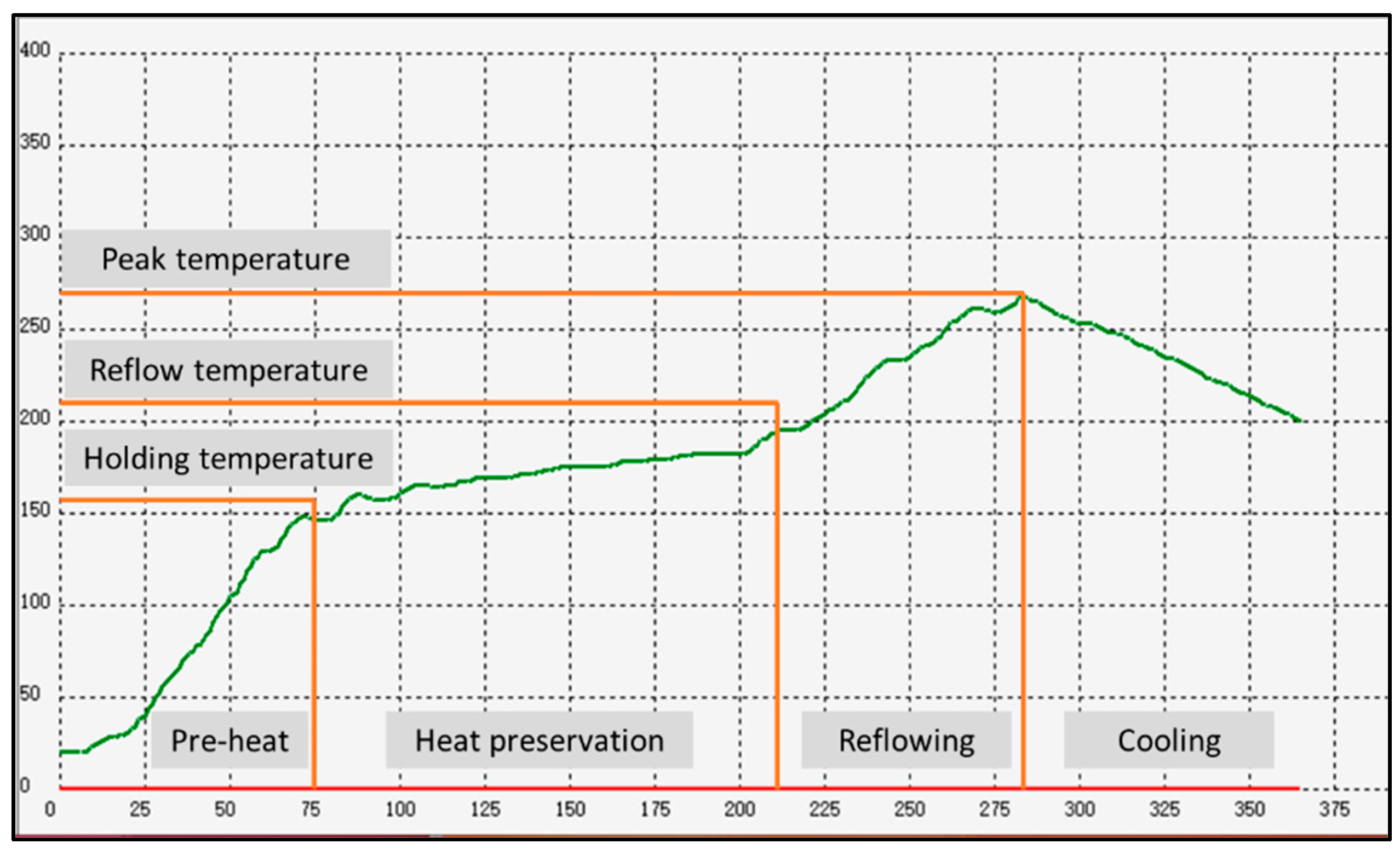
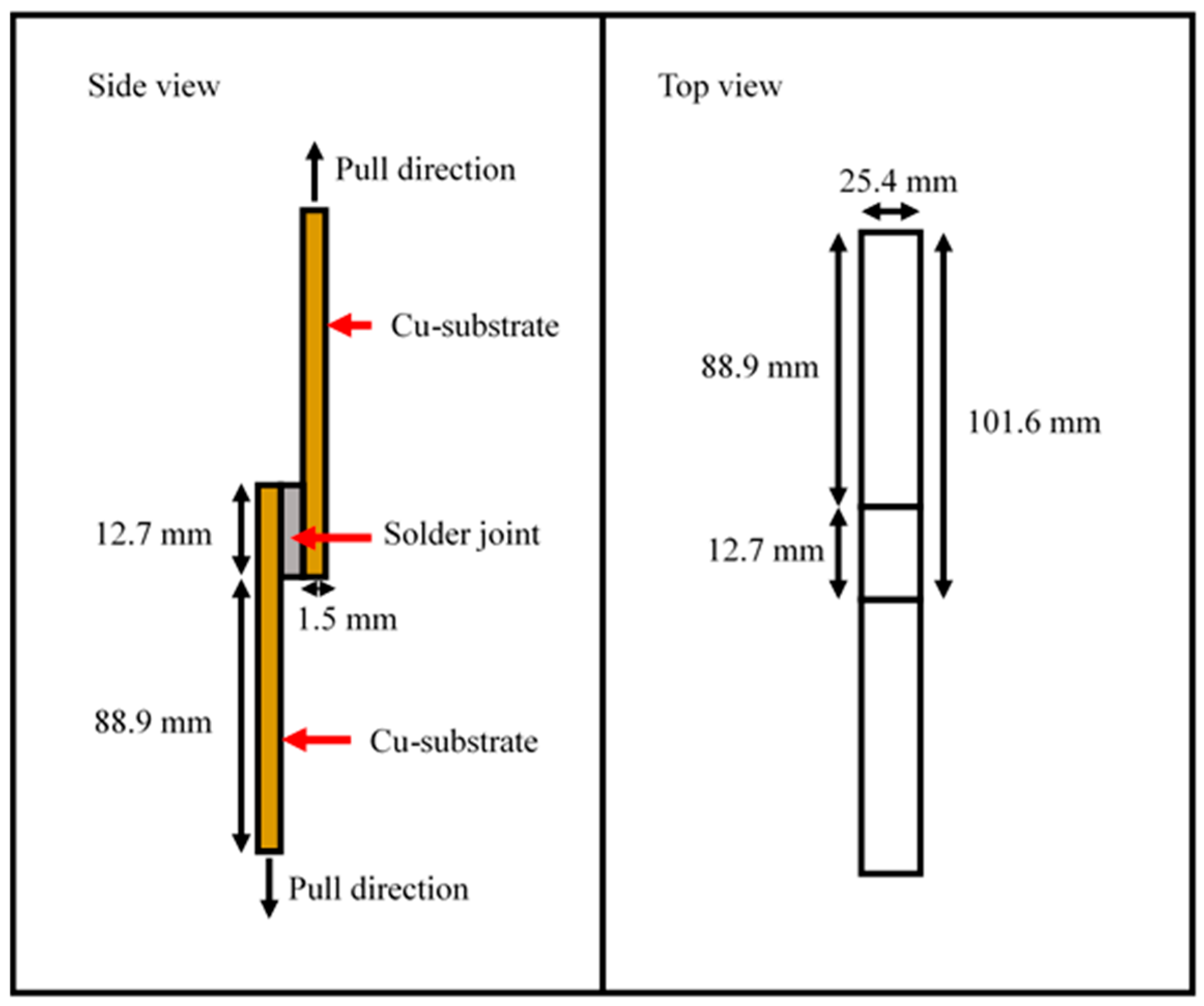
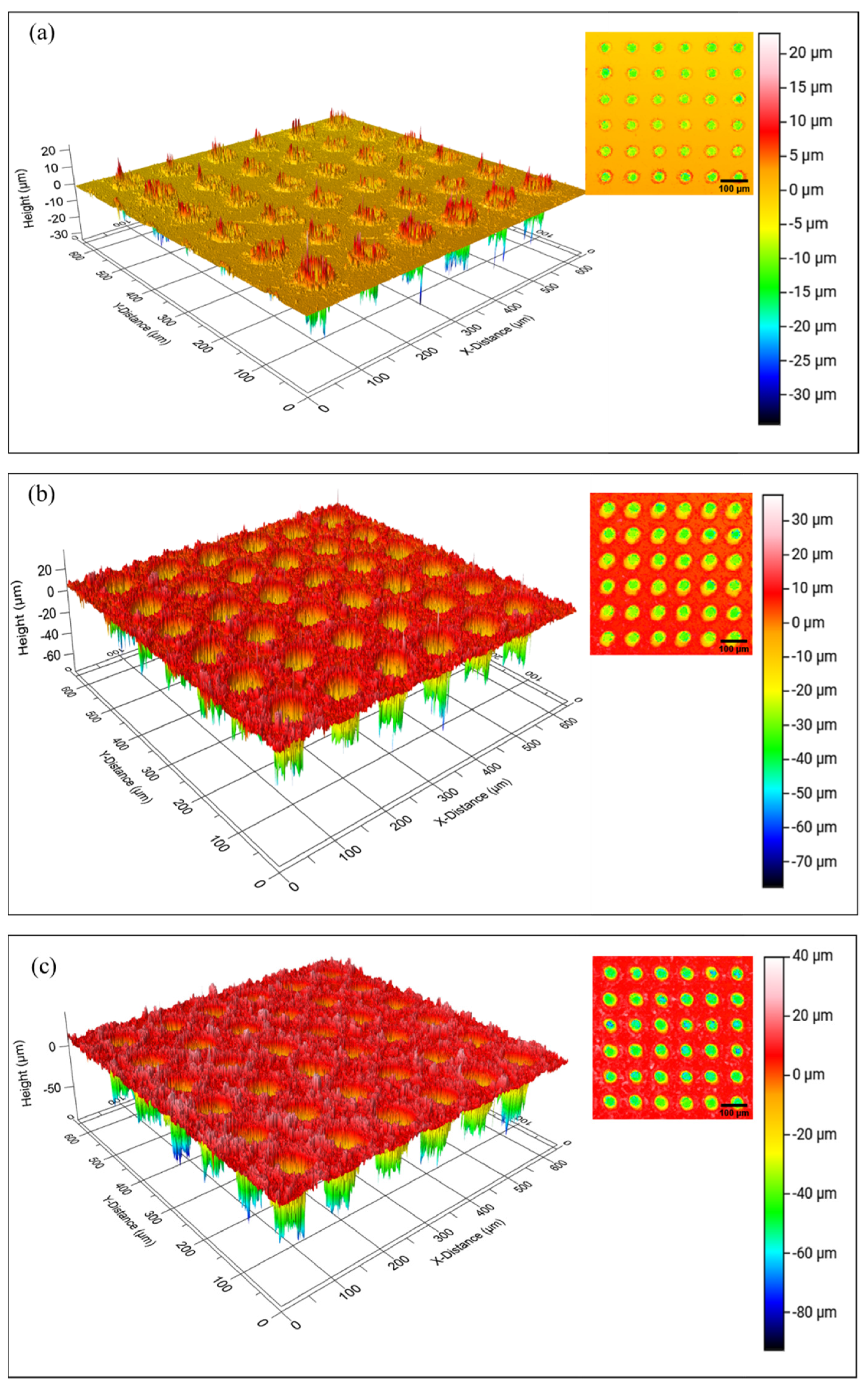
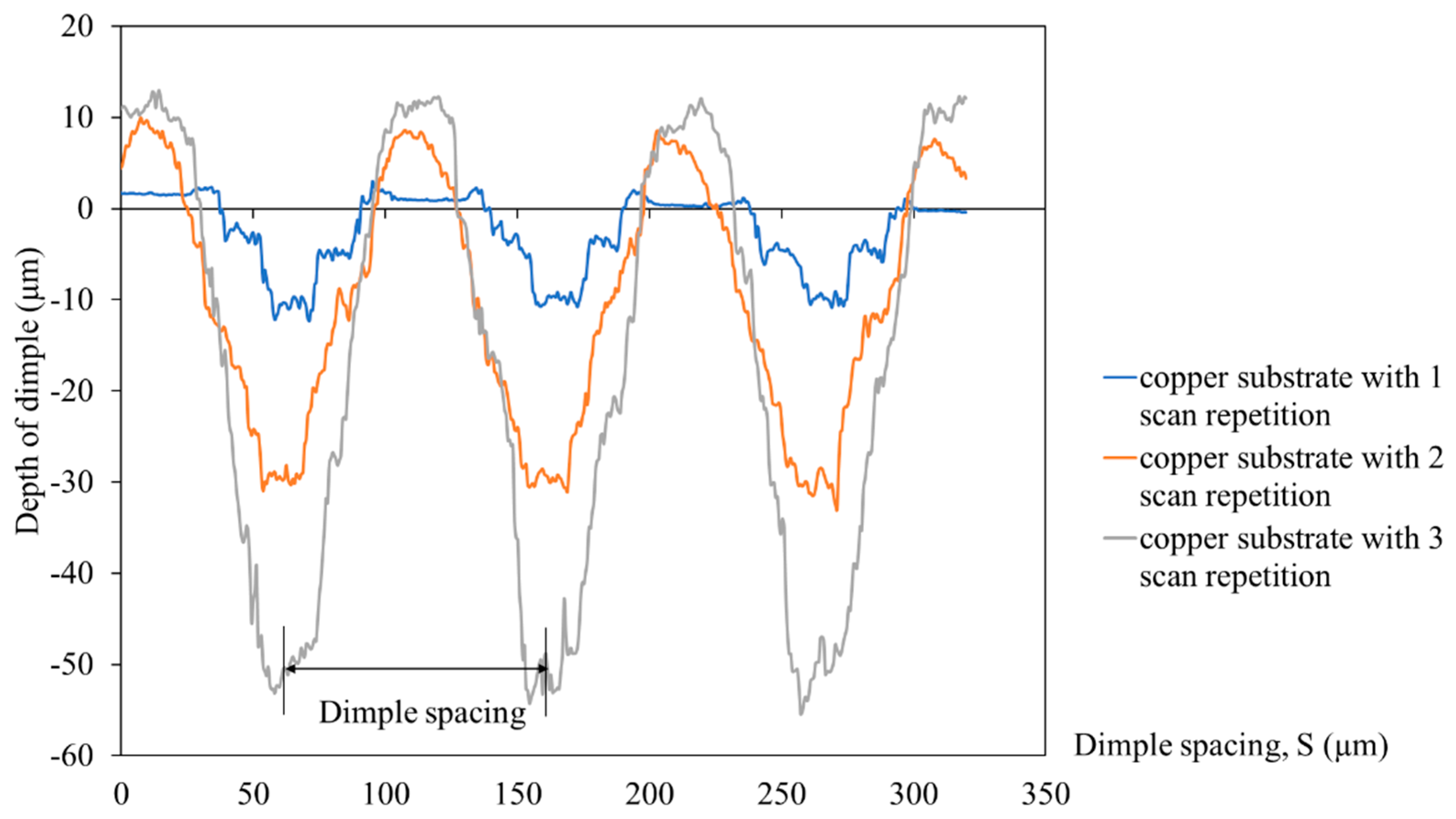
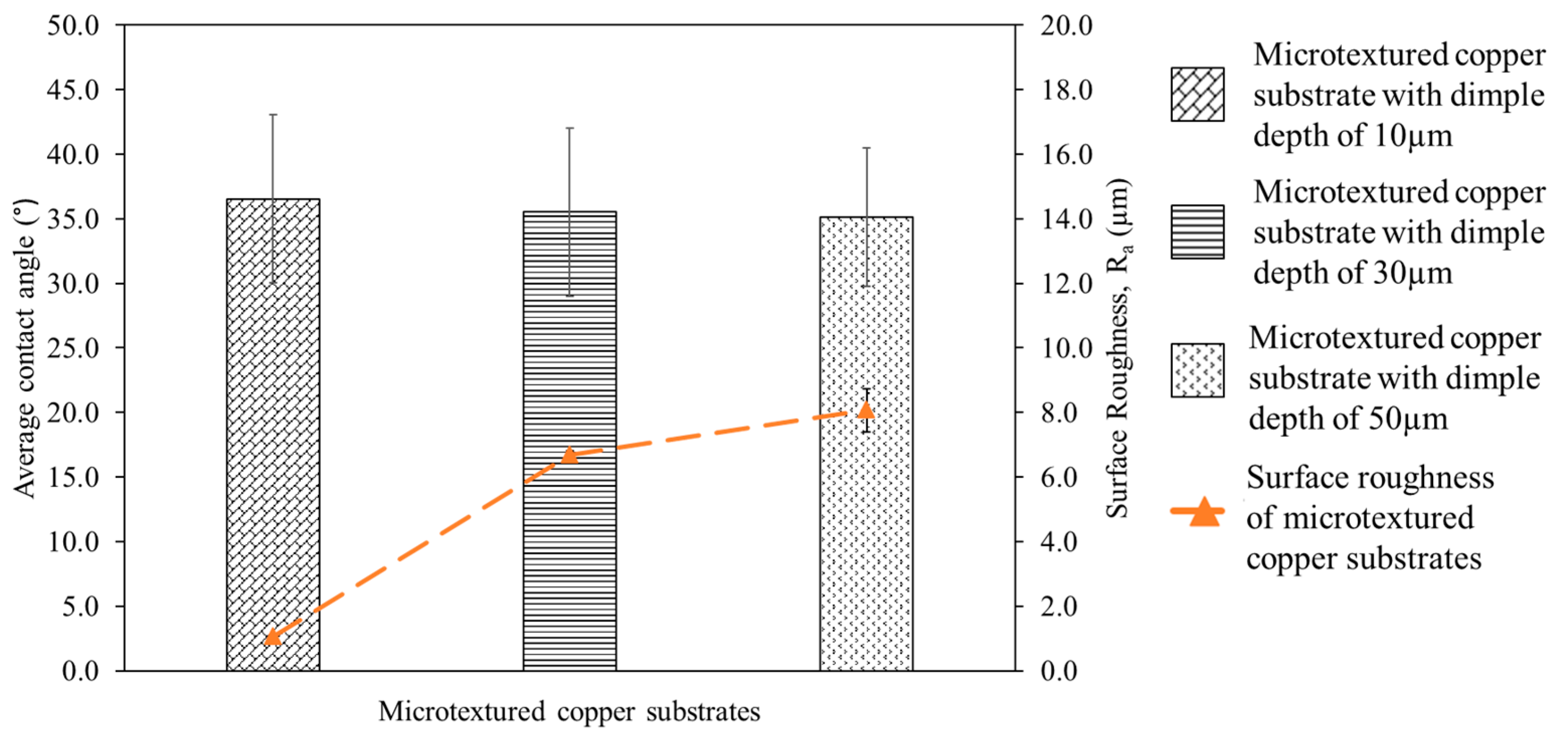
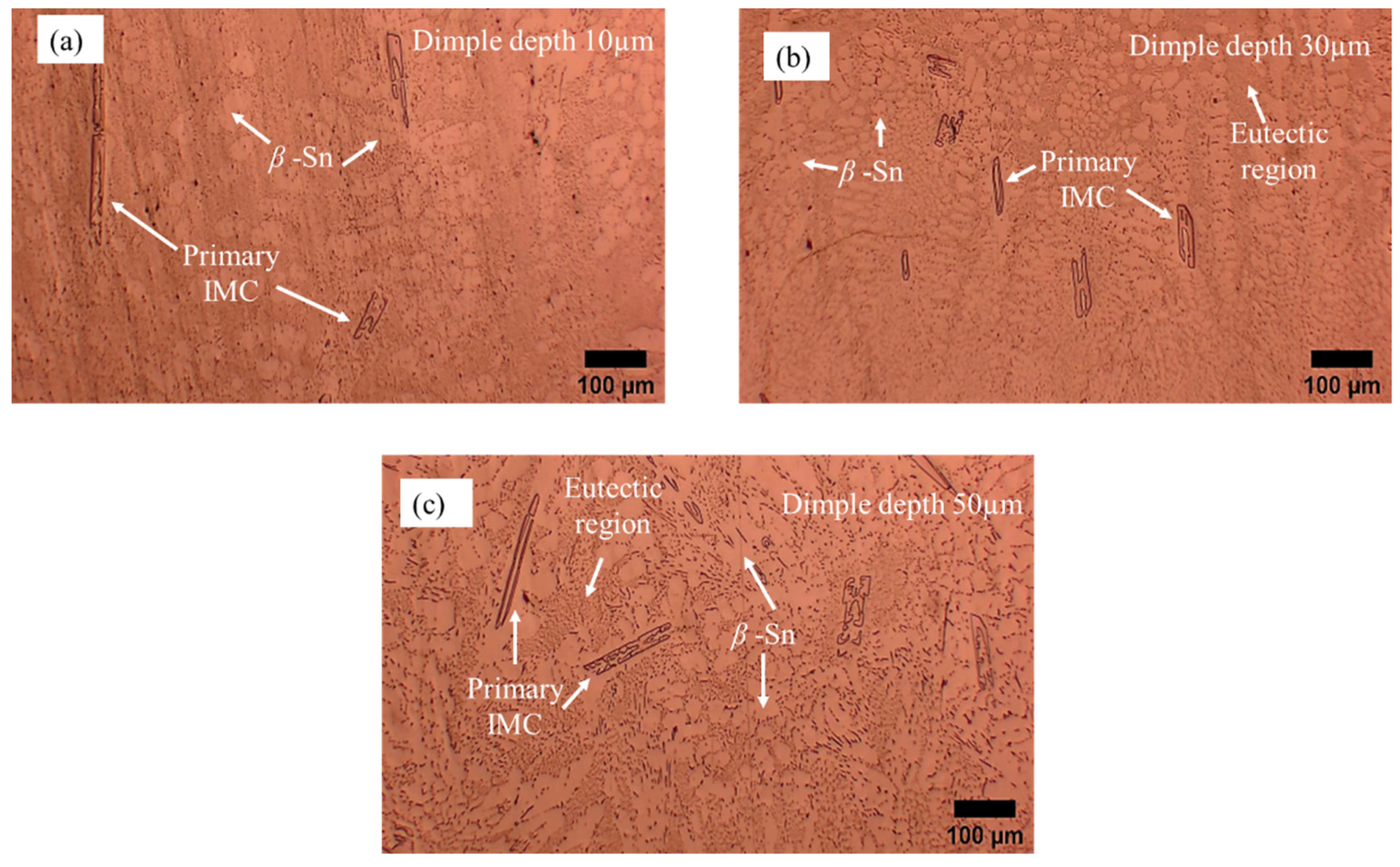

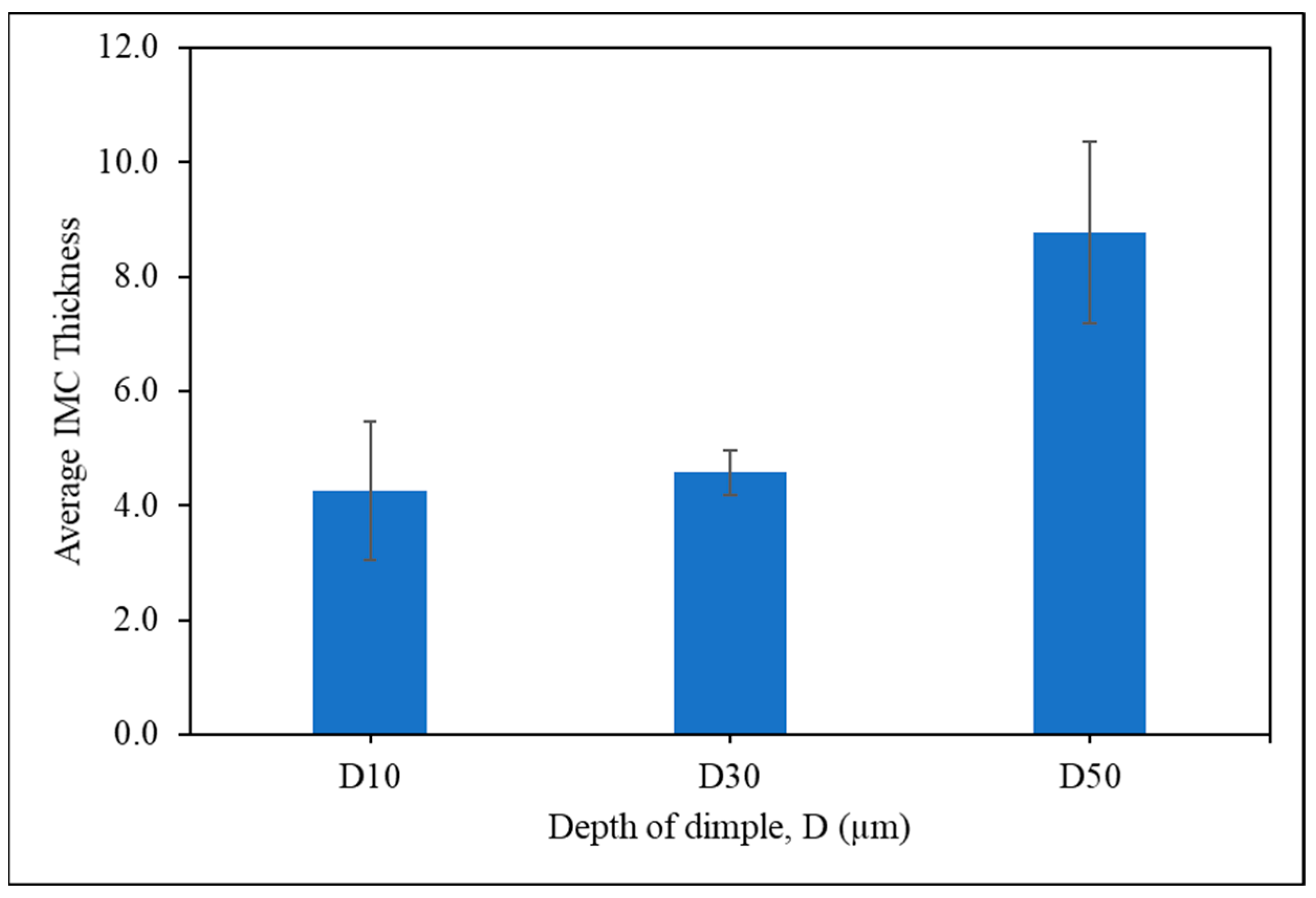
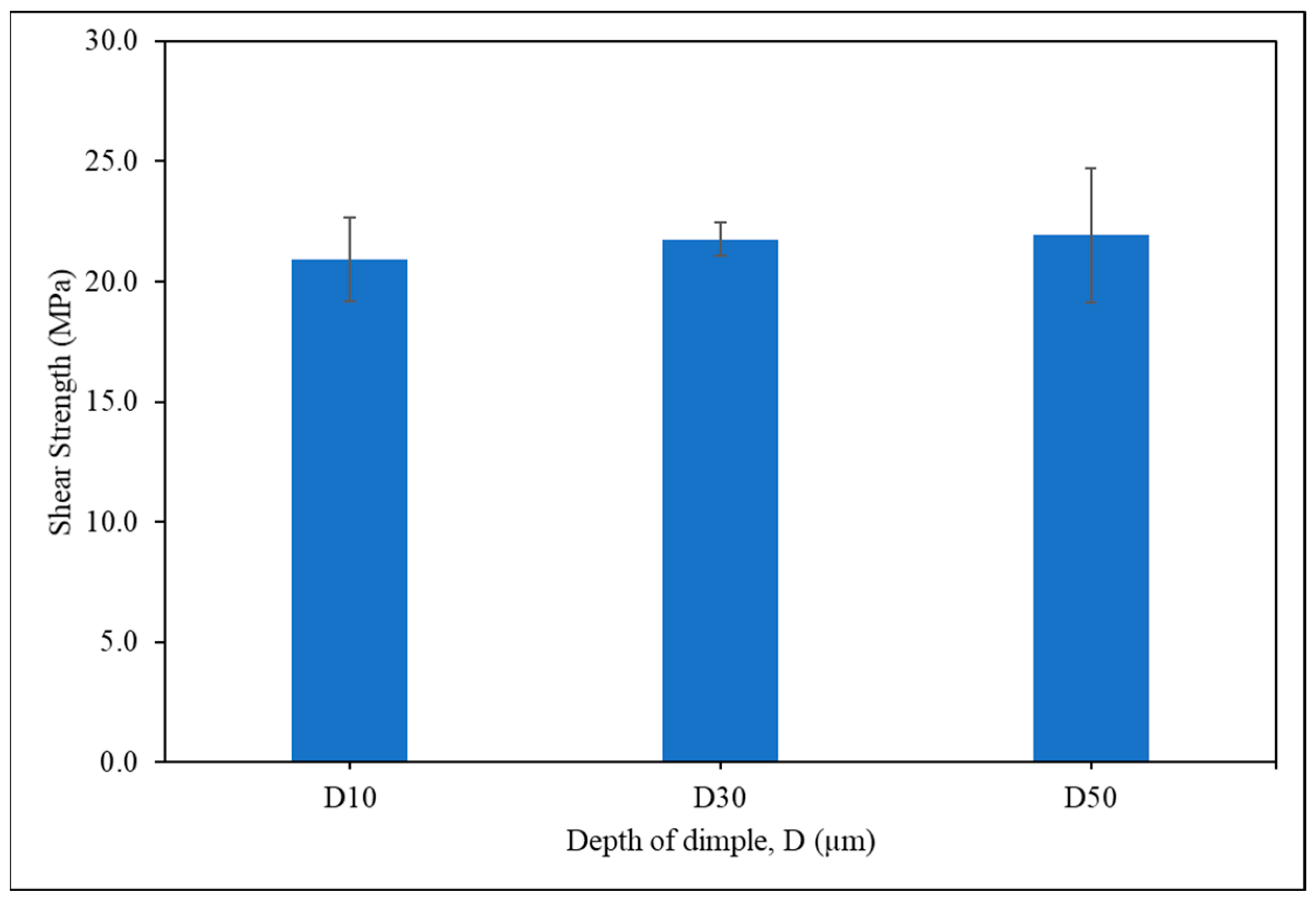
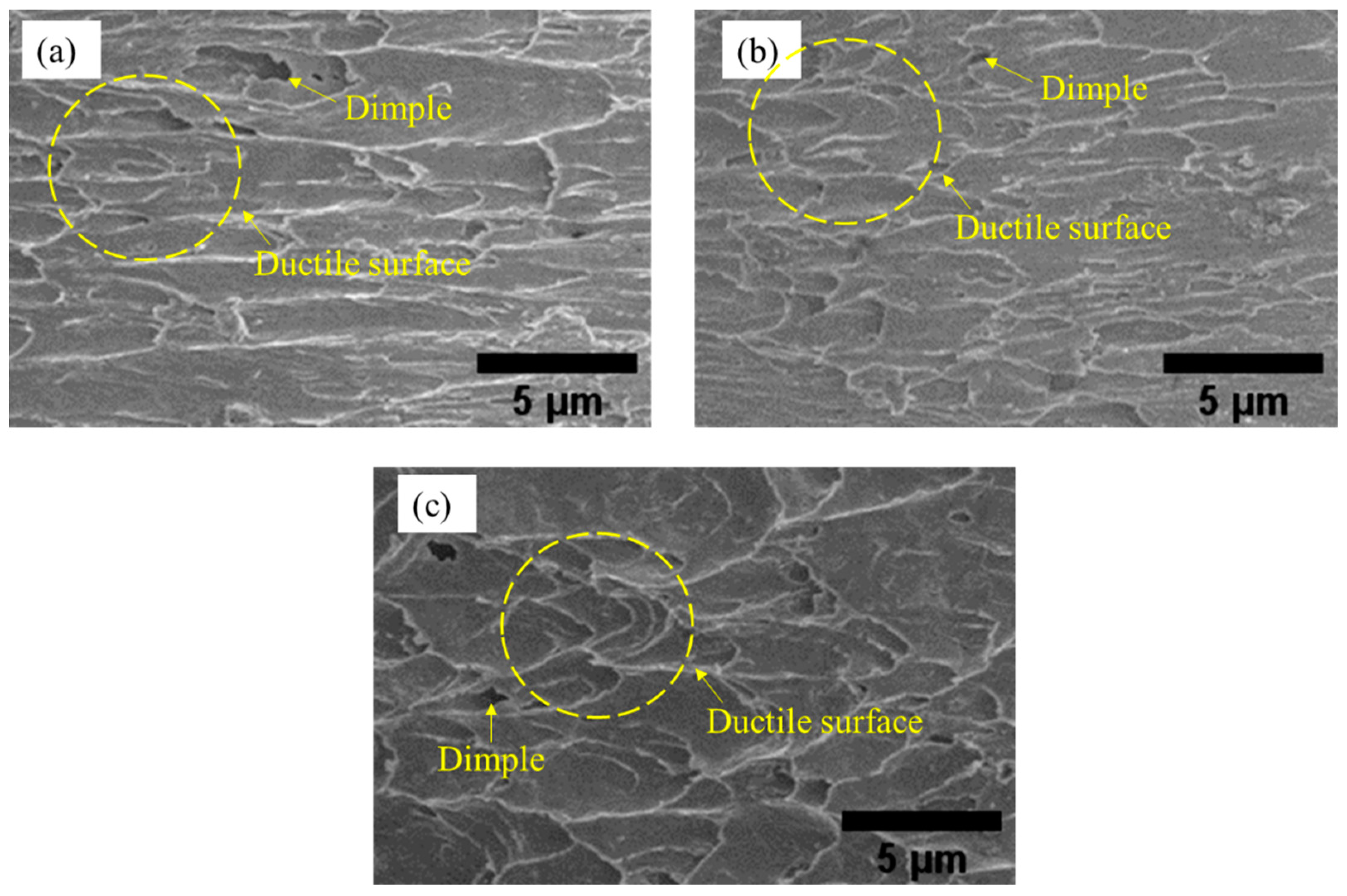
| Parameter | Value |
|---|---|
| Name | Ytterbium Fiber Laser Marking Machine |
| Model | ML-MF-A01 |
| Wavelength (nm) | 1064 |
| Scanning speed (mm/s) | 4000 |
| Laser power (W) | 70 |
| Frequency (kHz) | 20 |
Disclaimer/Publisher’s Note: The statements, opinions and data contained in all publications are solely those of the individual author(s) and contributor(s) and not of MDPI and/or the editor(s). MDPI and/or the editor(s) disclaim responsibility for any injury to people or property resulting from any ideas, methods, instructions or products referred to in the content. |
© 2022 by the authors. Licensee MDPI, Basel, Switzerland. This article is an open access article distributed under the terms and conditions of the Creative Commons Attribution (CC BY) license (https://creativecommons.org/licenses/by/4.0/).
Share and Cite
Roduan, S.F.; Wahab, J.A.; Salleh, M.A.A.M.; Mahayuddin, N.A.H.M.; Abdullah, M.M.A.B.; Halil, A.B.M.; Zaifuddin, A.Q.S.; Muhammad, M.I.; Sandu, A.V.; Baltatu, M.S.; et al. Effectiveness of Dimple Microtextured Copper Substrate on Performance of Sn-0.7Cu Solder Alloy. Materials 2023, 16, 96. https://doi.org/10.3390/ma16010096
Roduan SF, Wahab JA, Salleh MAAM, Mahayuddin NAHM, Abdullah MMAB, Halil ABM, Zaifuddin AQS, Muhammad MI, Sandu AV, Baltatu MS, et al. Effectiveness of Dimple Microtextured Copper Substrate on Performance of Sn-0.7Cu Solder Alloy. Materials. 2023; 16(1):96. https://doi.org/10.3390/ma16010096
Chicago/Turabian StyleRoduan, Siti Faqihah, Juyana A. Wahab, Mohd Arif Anuar Mohd Salleh, Nurul Aida Husna Mohd Mahayuddin, Mohd Mustafa Al Bakri Abdullah, Aiman Bin Mohd Halil, Amira Qistina Syamimi Zaifuddin, Mahadzir Ishak Muhammad, Andrei Victor Sandu, Mădălina Simona Baltatu, and et al. 2023. "Effectiveness of Dimple Microtextured Copper Substrate on Performance of Sn-0.7Cu Solder Alloy" Materials 16, no. 1: 96. https://doi.org/10.3390/ma16010096
APA StyleRoduan, S. F., Wahab, J. A., Salleh, M. A. A. M., Mahayuddin, N. A. H. M., Abdullah, M. M. A. B., Halil, A. B. M., Zaifuddin, A. Q. S., Muhammad, M. I., Sandu, A. V., Baltatu, M. S., & Vizureanu, P. (2023). Effectiveness of Dimple Microtextured Copper Substrate on Performance of Sn-0.7Cu Solder Alloy. Materials, 16(1), 96. https://doi.org/10.3390/ma16010096









